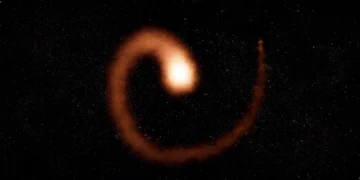For years, astronomers have been keeping an eye on WR 104, a massive binary system in the constellation Sagittarius, nicknamed the “Death Star” due to concerns about its potential to unleash a deadly gamma-ray burst (GRB). Initial observations suggested that if one of its stars went supernova, the resulting burst of energy could be pointed directly at Earth.
What Is WR 104 and Why Was It a Concern?
WR 104 is a Wolf-Rayet star, a type of star that is incredibly hot, massive, and nearing the final stages of its life. It is accompanied by a massive OB star, and together, they form a striking pinwheel-shaped spiral of dust, generated by the interaction of their stellar winds. This system is about 8,000 light-years away and has long been considered a candidate for a future supernova explosion.
The concern arose when astronomers suspected that WR 104’s rotational poles might be aligned with Earth. If one of these stars were to explode in a hypernova, the resulting GRB could send an intense beam of radiation directly at our planet, potentially devastating Earth’s atmosphere and causing mass extinctions. This led to WR 104 being dubbed the “cosmic Death Star.”
Gamma-Ray Bursts: The Universe’s Most Powerful Explosions
Gamma-ray bursts are among the most energetic phenomena in the universe. They occur when a massive star collapses into a black hole, releasing an enormous amount of energy in the form of two highly focused beams. If one of these beams is directed at Earth, it could strip away the ozone layer, exposing the planet to deadly ultraviolet radiation from the Sun and leading to catastrophic climate changes.
GRBs are typically observed in distant galaxies, but having one occur within our own Milky Way would be an unprecedented event. The prospect of WR 104 being aimed directly at us was, therefore, a terrifying thought.
The Keck Observatory’s Game-Changing Discovery
Recent observations led by astronomer Grant Hill at the Keck Observatory in Hawaii have completely changed our understanding of WR 104’s orientation. Using three sophisticated instruments—the Low Resolution Imaging Spectrometer (LRIS), Echellette Spectrograph and Imager (ESI), and Near-Infrared Spectrograph (NIRSPEC)—Hill’s team found that WR 104’s orbit is tilted by 30-40 degrees from previous estimates.
This means that the system’s rotational axis is not aligned with Earth, greatly reducing the chances of a GRB being aimed at us. In other words, we are safe from this particular cosmic catastrophe.
Unanswered Mysteries: The Puzzle of the Pinwheel Spiral
While this is good news for Earth, it also raises new questions. If WR 104’s orbit is tilted, why does its spiral-shaped dust plume appear to be face-on from our perspective? This contradicts current models of dust formation in colliding wind binary systems.
One possible explanation is that the dust plume might be affected by strong stellar winds from both stars, distorting the expected patterns of dust formation. Another theory suggests that magnetic fields could be influencing the distribution of dust, creating an illusion that the system is aligned differently than it actually is. This anomaly remains an exciting topic for further research.
The Life Cycle of a Wolf-Rayet Star and Its Fate
Wolf-Rayet stars are known for their extreme mass loss, shedding their outer layers through intense radiation pressure. This phase is often considered the prelude to a supernova, marking the final evolutionary stage of some of the most massive stars in the universe.
For WR 104, the eventual supernova explosion is inevitable, but the big question is when. Predictions range from a few thousand years to a hundred thousand years. While this seems like a long time in human terms, in the grand scale of cosmic events, it’s just around the corner.
If WR 104 does explode, it could briefly outshine an entire galaxy, releasing vast amounts of energy. However, because its axis is not aimed at us, we won’t experience any catastrophic effects. Instead, astronomers will have a front-row seat to one of the most spectacular cosmic events in our galaxy.
What’s Next? Future Observations and the Role of New Telescopes
Even though WR 104 no longer poses a direct threat to Earth, it remains an extremely valuable subject for research. Future observations using NASA’s James Webb Space Telescope (JWST) and the upcoming European Extremely Large Telescope (E-ELT) could help clarify the mystery of its dust formation and provide deeper insights into the late stages of massive star evolution.
Additionally, astronomers will continue to study other potential supernova progenitors that might have GRB-aligned rotational axes. While WR 104 is off the list, there are still many unknown variables in the study of high-energy stellar explosions.
Another exciting avenue of research is the detection of pre-supernova signals. Scientists are looking into how massive stars exhibit signs of instability months to years before exploding. This could give us unprecedented early warning systems for future nearby supernovae.
How WR 104 Compares to Other Supernova Candidates
WR 104 is not the only supernova candidate under scrutiny. Other Wolf-Rayet stars, such as Eta Carinae, Betelgeuse, and VY Canis Majoris, are also expected to go supernova at some point. Each of these stars has its own unique characteristics, making them valuable for comparison.
For example, Betelgeuse, located just 700 light-years away, has already shown signs of dimming, leading to speculation about an impending explosion. However, like WR 104, it does not pose a threat to Earth. Understanding how these stars behave before their final explosion is crucial for predicting future cosmic events.
Conclusion: Cosmic Relief and New Questions
The latest findings provide reassurance that WR 104’s deadly gamma-ray beams will not be aimed at Earth when it eventually explodes. However, the system has presented astronomers with a new puzzle regarding the nature of its spiral dust formation.



















